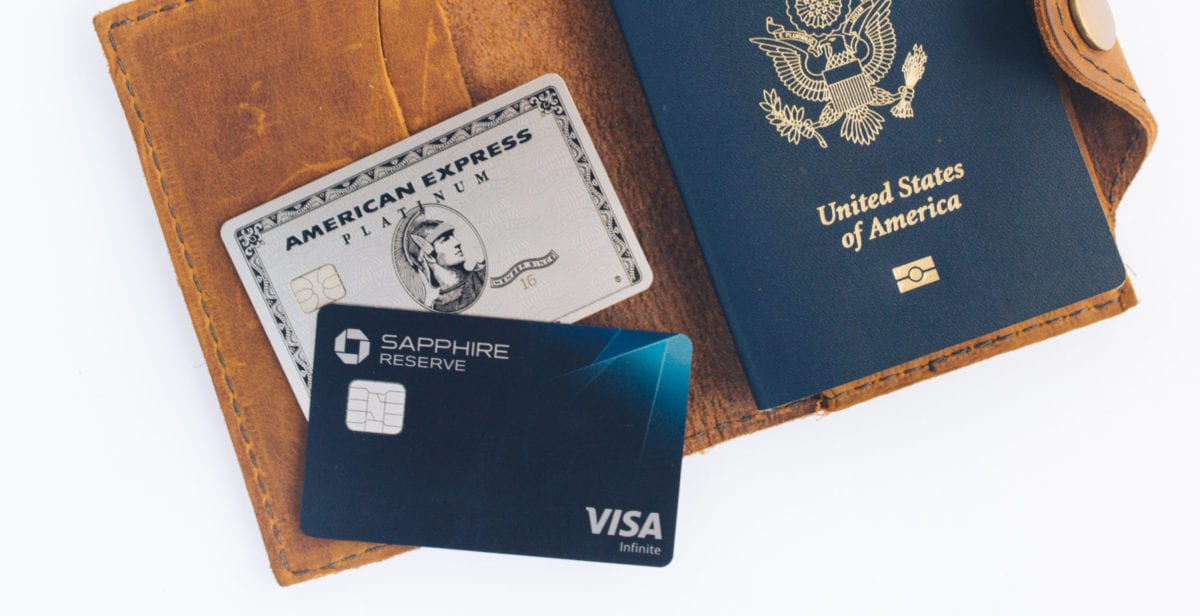Chase and American Express have dominated the travel rewards credit card space for years. And while other banks like Capital One, Citi, and even Wells Fargo have gotten in on the action, these two are still the gold standard for most travelers.
This is thanks, in large part, to cards like the *chase sapphire preferred* and the *amex gold card*.
With big welcome offers, bonus point-earning opportunities, and plenty of statement credits to offset the annual fees, there's a lot to love about both cards.
Understandably, this has led to many travelers putting these cards head-to-head to determine a winner. Ultimately, either of these cards would make a great addition to your wallet – and it could even make sense to hold both. But if you're forced to choose, some key differences could sway you one way or the other.
Let's take a look at how the Amex Gold and Chase Sapphire Preferred stack up in a number of key categories.
Benefits Overview
| Card | American Express® Gold Card | Chase Sapphire Preferred Card |
|---|---|---|
| Welcome Bonus | *amex gold bonus* | *csp bonus* |
| Points Earning | 4x points per dollar at restaurants worldwide(up to $50,000 annually, then 1x) 4x points per dollar at U.S. supermarkets (up to $25,000 of spending annually, then 1x) 3x points per dollar on flights booked direct or through American Express Travel® 2x points on prepaid hotels and rental cars booked through American Express Travel® | 3x on dining 3x points for online grocery purchases 3x points on select streaming services 2x points per dollar spent on travel purchases 5x total points on travel purchased through Chase Ultimate Rewards® |
| Transfer Partners | 17 Airline partners 3 Hotel partners | 11 Airline partners 3 Hotel partners |
| Perks | Up to $10 monthly dining credit, up to $100 Resy credit, up to $84 Dunkin' credit in the U.S., up to $10 monthly Uber Cash to use on rides or Uber Eats in the U.S. | Chase Pay Yourself Back Primary rental car insurance Trip delay Cancelation protection/insurance Baggage loss and delay protection |
| Annual Fee | $325 (see rates & fees) | annual_fees |
Welcome Offer Bonus
Both cards recently rolled out big new welcome offers, giving travelers the opportunity to earn a ton of points to fuel their future travels. Here's what's at stake with both cards.
- *chase sapphire preferred*: bonus_miles_full
- *amex gold card*: bonus_miles_full
If the Amex Gold's welcome offer has you confused, you're not alone. Here's how it works: After you submit your application – but before you accept the card (if you are approved) and your credit score is pulled – Amex will let you know the exact welcome offer you are eligible for. It's a bit of a toss-up, but the upside is the shot at a much bigger bonus than what the card previously offered.
It's also worth noting that while the Amex Gold Card requires a little more spending, you get an additional three months to to get it done. If you don't regularly spend big, that could make it the easy choice for some.
Winner: Which Card Comes With a Better Bonus?
In some cases, bigger is better, and the Amex Gold Card offers the chance at the biggest possible bonus. Add in the fact that you get an additional three months to meet the spending requirement, and it's the clear winner in this category.
Learn more about the *amex gold*
Welcome Bonus Eligibility
As great as the current bonuses on both the Chase Sapphire Preferred and American Express Gold Card are, they don't matter much if you can't even earn them. Both banks have some restrictions you'll need to keep in mind to give yourself the best chance of being approved for either card.
Chase Sapphire Preferred® Card
This card is impacted by the Chase 5/24 rule. This means that if you have opened five or more credit cards in the past 24 months from any bank (not just Chase cards), you will not be approved for the Chase Sapphire Preferred card. And that's true regardless of your credit score or history with the bank, making it a big reason why we recommend starting your travel rewards credit card journey with Chase cards.
To complicate matters further, Chase recently changed up its bonus eligibility rules making it harder than ever to determine who is and isn't eligible for the bonus. The one thing that we seem to know (almost) for certain is that you won't be eligible for the Sapphire Preferred's bonus offer if you currently have the *chase sapphire reserve* open. While it's possible to have both cards at the same time now, don't expect to earn a bonus if you decide to go this route.
Beyond that the terms and conditions are filled with a bunch of “mays” and “may nots,” giving the bank plenty of wiggle room to deny travelers for the bonus. The good news is that there's no harm in finding out whether or not you're eligible: Chase recently introduced a new pop-up tool that lets applicants know if they aren't eligible for the bonus before actually hitting submit and having their credit pulled.
American Express® Gold Card
Generally speaking, Amex allows you to earn a welcome bonus on each of their cards once per lifetime … but you have to do it in the right order.
Last year, American Express began adding new restrictions to its welcome offers, limiting whether you can earn a bonus based upon other Amex cards you have – or have had. The key here is starting at the bottom and working your way up: If you have (or have had) Amex's top-tier *amex platinum*, you won't be eligible for the Gold card – regardless of whether or not you've ever had it before.
One nice thing with Amex is that their “Apply With Confidence” tool will let you know before you submit your application and pull your credit whether or not you are eligible to earn the welcome bonus. So just like the Sapphire Preferred, even if you're not sure … it is worth a try. You can always cancel before your card application is officially submitted.
Winner: Which Card is Easier to Get?
The Chase 5/24 rule is extremely restrictive. While Chase looks at all of your card applications from every bank, Amex largely only considers your history with American Express. That makes it much easier for many people to get approved for the Amex Gold card.
Learn more about the *amex gold*
Annual Fee
While neither card costs as much as some of the ultra-premium travel cards on the market these days, there's still a clear winner here.
The Chase Sapphire Preferred debuted over a decade ago with an annual fee of just $95 – and that's still where it sits today. Meanwhile, a recent refresh has brought the Amex Gold Card's annual fee up a whopping $325 (see rates and fees) per year.
For many, choosing the right credit card comes down to this single factor. There's no question that the Amex Gold card comes with a number of benefits and bonus-earning categories that can offset the annual fee and justify the much higher price tag. However, when it comes to the upfront expense, the Chase Sapphire Preferred credit card is the clear winner when we look solely at out-of-pocket costs.
Winner: Which Card Wins on Annual Fees?
The Chase Sapphire Preferred only charges $95 per year, which is a much easier-to-swallow annual fee for anyone looking for a great entry-level credit card.
Learn more about the *csp*.
Earning Points
Once you get beyond the bonus, you'll earn points differently with these two cards.
The Chase Sapphire Preferred earns 3x points per dollar spent on dining, including eligible delivery services, 3x points per dollar spent on online grocery purchases (excluding Target, Walmart, and wholesale clubs), and 3x points per dollar spent on select streaming services.
You will also earn 2x points per dollar spent on travel purchases, and up to $50 in statement credits each account anniversary year for hotel stays purchased through Chase Travel℠.
The Amex Gold Card, on the other hand, earns 4x Membership Rewards points per dollar spent at all restaurants worldwide (up to $50,000 spent each year, then 1x) and 4x Membership Rewards points per dollar spent at U.S. supermarkets (on up to $25,000 of spending annually, then 1x).
Additionally, the Amex Gold card will earn 3x Membership Rewards points per dollar spent on flights booked directly with the airline or through American Express Travel® and 2x points on prepaid hotel, rental car, and cruise purchases through Amex Travel. You'll earn 1x point per dollar spent on other eligible purchases.
The Amex Gold offers some of the best bonuses on groceries and restaurants of any card, period. It even beats Chase's top-tier premium travel credit card, the *chase sapphire reserve*, in terms of point-earning. These spending categories alone are a big part of the reason we think the Amex Gold card is largely worth its annual fee. While the bonus categories on Chase are also good, we feel the 4x points categories on the Amex Gold Card will help people maximize more of their everyday spending.
Winner: Which Card Earns More Points?
If you spend a decent amount on food, both at restaurants and at the grocery store, the Amex Gold card is one of the best options, period – not just in this matchup.
Learn more about the *amex gold*
Transfer Partners
Transferring points to separate airline and hotel accounts can unlock some serious value. The Amex Gold Card and Chase Sapphire Preferred cards are both strong options that come with several transfer partners for getting more out of your points.
Chase Sapphire Preferred® Transfer Partners
All told, Chase points can transfer to 11 airlines and three hotel brands. Here's the full list of Chase's transfer partners.
| Program | Type | Transfer Ratio | Transfer Time |
|---|---|---|---|
| Aer Lingus | Airline | 1:1 | Instant |
| Air Canada Aeroplan | Airline | 1:1 | Instant |
| Air France/KLM | Airline | 1:1 | Instant |
| British Airways | Airline | 1:1 | Instant |
| Emirates | Airline | 1:1 | Instant |
| Iberia Plus | Airline | 1:1 | Instant |
| JetBlue | Airline | 1:1 | Instant |
| Singapore Air | Airline | 1:1 | 12-24 hours |
| Southwest Airlines | Airline | 1:1 | Instant |
| United Airlines | Airline | 1:1 | Instant |
| Virgin Atlantic | Airline | 1:1 | Instant |
| World of Hyatt | Hotel | 1:1 | Instant |
| IHG | Hotel | 1:1 | 1 day |
| Marriott Rewards | Hotel | 1:1 | 2 days |
Read our guide on the best ways to use Chase Ultimate Rewards points.
American Express® Gold Transfer Partners
American Express Membership Rewards points can be transfer to nearly 17 airlines and three hotel brands. Unlike Chase, not all programs will transfer at a 1:1 ratio … and soon that list will include Emirates Skywards Miles. Amex also tacks on a small fee of 0.06 cents per point (capped at $99) on transfers to U.S.-based airlines (like Delta or JetBlue).
This means if you wanted to transfer 30,000 Membership Rewards to Delta to book a hot SkyMiles Flash Sale to Europe, you'd be charged an $18 dollar fee for the privilege of turning those points into SkyMiles. Not huge … but it can add up over time. Chase, on the other hand, does not charge this fee when transferring points to its U.S.-based airline partners like United and Southwest.
Here's the full list of American Express transfer partners.
| Program | Type | Transfer Ratio | Transfer Time |
|---|---|---|---|
| Aer Lingus | Airline | 1:1 | Instant |
| AeroMexico | Airline | 1:1.6 | 3-5 days |
| Air Canada Aeroplan | Airline | 1:1 | Instant |
| Air France/KLM | Airline | 1:1 | Instant |
| ANA | Airline | 1:1 | 1-2 days |
| Avianca | Airline | 1:1 | Instant |
| British Airways | Airline | 1:1 | Instant |
| Cathay Pacific | Airline | 1:1 | Instant |
| Delta | Airline | 1:1 | Instant |
| Emirates | Airline | 1:1 | Instant |
| Etihad | Airline | 1:1 | Instant |
| Iberia | Airline | 1:1 | Up to 24 hours |
| JetBlue | Airline | 1.25:1 | Instant |
| Qantas | Airline | 1:1 | Instant |
| Qatar Airways | Airline | 1:1 | Instant |
| Singapore | Airline | 1:1 | Instant |
| Virgin Atlantic | Airline | 1:1 | Instant |
Read our guide on the best ways to use Amex Membership Rewards points
Winner: Which Has the Best Transfer Partners?
This one is too close to call. It will ultimately come down to which transfer partners you value more. Both offer one of the big four U.S. carriers (Chase has United and Amex has Delta) and a number of international carriers. Chase has the edge among hotels with Hyatt, but American Express has many more options and tends to offer more frequent transfer bonuses.
Perks & Additional Benefits
Both the Chase Sapphire Preferred and the Amex Gold Cards offer additional perks for card members above and beyond the benefits we've already covered.
Let's start with the Chase Sapphire Preferred. With this card, you'll get some of the best travel insurance of any card on the market. This includes both primary rental car insurance and trip delay and cancelation protection, as well as coverage for lost or delayed baggage. See our full review of the Chase Sapphire Preferred Card for more specific details on these perks.
In terms of credits, you can recoup over half the card's $95 annual fee by taking advantage of the Sapphire Preferred's annual $50 hotel credit. All you need to do is book your hotel stay through Chase Travel and you'll automatically be reimbursed up to $50 each year that you hold the card.
You'll also get a complimentary DashPass, for free DoorDash deliveries, and $10 off non-restaurant DoorDash orders each month. If you regularly use DoorDash, these two benefits alone can be enough to justify holding the Sapphire Preferred.
The Amex Gold Card, on the other hand, has a much higher annual fee of $325 (see rates & fees) – but it offers a bunch of statement credits that can make it well worth it.
For starters, you get up to $120 in annual dining credit (up to $10 per month) to be used at Grubhub, The Cheesecake Factory, Goldbelly, Wine.com, or Five Guys.
You'll also receive $120 of Uber Cash each year ($10 per month) to be used on rides or Uber Eats. If you frequently use Uber or order food through Uber Eats, this is a big win and further helps offset the cards annual fee.
Finally, Amex added a few new benefits to the Gold Card last year to help justify its price hike. You'll now get up to $100 per year in Resy credit – broken into semi-annual chunks of up to $50 each. And you'll also get up to $84 per year in statement credits for purchases at Dunkin' Donuts in the U.S. – broken up into chunks of $7 per month.
Just be warned: Unused credits don't roll over to the next month (or six months). These are all use-it-or-lose-it benefits
Winner: Which Card Has the Best Perks & Credits?
While the Amex Gold Card does have a higher annual fee, the perks and additional benefits it provides can easily offset that.
Learn more about the *amex gold*
Does it Make Sense to Have Both?
In the end, you can't go wrong with either card – especially if you're just starting out in the world of points and miles.
For some travelers, though, it may make sense to hold both cards as they are a great way to earn two of the most valuable points – Chase Ultimate Rewards and Amex Membership Rewards – and diversify your points and miles balances.
Having both the *amex gold card* and *chase sapphire preferred* cards in your wallet means you can rack up points in two different rewards programs – and that keeps your award travel options open. If you have a stash of both Chase Ultimate Rewards and Amex Membership Rewards points, you can use them to fly almost any airline and your options for redeeming points for hotel stays are broader, too. So when a great deal or redemption pops up, you have the flexibility to jump on it.
And with different bonus categories, holding both cards ensures you're earning the maximum amount of points on any spending you do – whether that's swiping your Amex Gold card while eating out or grocery shopping to get 4x the Amex Membership Rewards or paying for your next trip with your Chase Sapphire Preferred card to earn 2x the Chase Ultimate Rewards points.
But remember: You should only open one (or both) of these cards if you can afford to. Credit cards are serious business. You should never apply for a credit card if you're already in debt, and never charge more to a credit card than you can afford to pay off immediately.
Bottom Line
By the numbers, both the Amex Gold and the Chase Sapphire Preferred Card take three categories – and one is a tie. But every cardholder should weigh each of these individual categories differently.
Deciding between the *chase sapphire preferred* and the *amex gold card* should boil down to which categories you value the most. While there are pros and cons to either, both cards offer a strong value proposition for travelers and could easily deserve a spot in your wallet.







You left out one important point: Service.
AMEX customer service beats every other card hands down. Easy to reach the right person and they go out of their way to help. For me, that beats everything else.